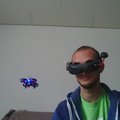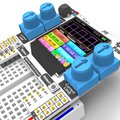 @happyday.mjohnson the general rule is to do as little preprocessing as possible. We do run FFTs on audio to get features, but we take images and raw accelerometer data
@happyday.mjohnson the general rule is to do as little preprocessing as possible. We do run FFTs on audio to get features, but we take images and raw accelerometer data
 @Sébastien Vézina keep reading :) You won't need to know much of the underlying theory to build some amazing stuff
@Sébastien Vézina keep reading :) You won't need to know much of the underlying theory to build some amazing stuff
 How well does the square identifier model detects the backs of a human as a human? (have some problems with that)
How well does the square identifier model detects the backs of a human as a human? (have some problems with that)
 @Dan Maloney Our Dan had a similar idea for recognizing pigeons! :)
@Dan Maloney Our Dan had a similar idea for recognizing pigeons! :)
 @mtfurlan sorry, I've been having infrastructure troubles, will look into it tonight
@mtfurlan sorry, I've been having infrastructure troubles, will look into it tonight
 @Pete Warden giving away my million dollar idea!! haha
@Pete Warden giving away my million dollar idea!! haha
 @pete - in my way minimum exploration of accel data, there seems to be a benefit on some level of filtering, But I must admit I'm a bit clueless. I guess to me it makes intuitive sense. Since modeling is such a "Dark Art"
@pete - in my way minimum exploration of accel data, there seems to be a benefit on some level of filtering, But I must admit I'm a bit clueless. I guess to me it makes intuitive sense. Since modeling is such a "Dark Art"
 @happyday.mjohnson yes colab is awesome -- it's free and convenient -- and you get GPUs too! A lot of folks think you need a lot of data and resources to get started -- but you actually don't. :)
@happyday.mjohnson yes colab is awesome -- it's free and convenient -- and you get GPUs too! A lot of folks think you need a lot of data and resources to get started -- but you actually don't. :)
 from youtube "PTS
from youtube "PTS
any boards planned with MCUs that include tensor accelerators like the MAIX?'
 @Arsenijs No worries I completely understand. Maybe have it echo your message back to IRC so it's clear if it doesn't work?
@Arsenijs No worries I completely understand. Maybe have it echo your message back to IRC so it's clear if it doesn't work?
 @Pete Warden @Daniel Situnayake Incredible book, a lot thanks
@Pete Warden @Daniel Situnayake Incredible book, a lot thanks
 @Meghan i just wish I understood the path from colab -> model on CP.
@Meghan i just wish I understood the path from colab -> model on CP.
 @happyday.mjohnson I'm a newbie to accelerometer data too, but our Beijing team are working on the demo, and seem to have made a lot of progress without much preprocessing. The networks themselves are good at learning features
@happyday.mjohnson I'm a newbie to accelerometer data too, but our Beijing team are working on the demo, and seem to have made a lot of progress without much preprocessing. The networks themselves are good at learning features
 Thank you @Andres Manjarres !!
Thank you @Andres Manjarres !!
 @pete - do you have a timeframe when we can learn from your accel work?
@pete - do you have a timeframe when we can learn from your accel work?
 @pete - it would be so cool to get this figured out before my parents pass away :-)
@pete - it would be so cool to get this figured out before my parents pass away :-)

 @happyday.mjohnson we'll have example code available by the end of the month!
@happyday.mjohnson we'll have example code available by the end of the month!
 @mtfurlan as soon as I have the "it doesn't forward" detection coded in, it will just re-get the HaD token and re-send it, in short, it will fix itself instead of just signalling "broken" =)
@mtfurlan as soon as I have the "it doesn't forward" detection coded in, it will just re-get the HaD token and re-send it, in short, it will fix itself instead of just signalling "broken" =)
 @Daniel - thank you. Where is the best place to follow for new postings?
@Daniel - thank you. Where is the best place to follow for new postings?

 Limor, PT I am working on the Hackaday Finals could I DM you about your M4 and 240x240 Displays (mechanical33486@icloud.com)
Limor, PT I am working on the Hackaday Finals could I DM you about your M4 and 240x240 Displays (mechanical33486@icloud.com)
 @John Loeffler post here! happy to answer anything!
@John Loeffler post here! happy to answer anything!
 @happyday.mjohnson Twitter is useful! I'd follow https://twitter.com/tensorflow for big announcements, and you can follow me (https://twitter.com/dansitu) for more fine-grained stuff
@happyday.mjohnson Twitter is useful! I'd follow https://twitter.com/tensorflow for big announcements, and you can follow me (https://twitter.com/dansitu) for more fine-grained stuff
 @Daniel ...sigh...ok...i stay off of THE twitter and THE Facebook...but for TF/Keras....
@Daniel ...sigh...ok...i stay off of THE twitter and THE Facebook...but for TF/Keras....
 @happyday.mjohnson we have a bunch of news, guides, projects, etc. that we post up here too : https://blog.adafruit.com/category/machine-learning/
@happyday.mjohnson we have a bunch of news, guides, projects, etc. that we post up here too : https://blog.adafruit.com/category/machine-learning/
 and we're adding more things here too: https://www.adafruit.com/index.php?main_page=category&cPath=1006
and we're adding more things here too: https://www.adafruit.com/index.php?main_page=category&cPath=1006
 @pt thank you. Your learning resources are incredible. Thank you for such an amazing company.
@pt thank you. Your learning resources are incredible. Thank you for such an amazing company.
 @happyday.mjohnson Twitter is surprisingly amazing for ML stuff, you can follow a lot of very interesting folks
@happyday.mjohnson Twitter is surprisingly amazing for ML stuff, you can follow a lot of very interesting folks
 one of our goals is to have something that is under $20 that does ML speech rec really good and something under $100 that does ML vision really good
one of our goals is to have something that is under $20 that does ML speech rec really good and something under $100 that does ML vision really good
 thanks @happyday.mjohnson
thanks @happyday.mjohnson
 all edge (not net connected)
all edge (not net connected)


 How fast can the 240x240 update i wanted to explore this for a moonshot powersupply that can be a crude oscope
How fast can the 240x240 update i wanted to explore this for a moonshot powersupply that can be a crude oscope
 @limor - you've got as much time as you want. Just let me know when you've got to get back to work
@limor - you've got as much time as you want. Just let me know when you've got to get back to work
 96Boards
96Boards
@Adafruit Industries Have you ever done any work on a hybrid Arm cortex-A / cortex-M chipset? Something like the STM32MP1 or equivalent? Could use MCU for realtime and cortex A for heavy lifting etc..
 why the hell is called 'edge computing' btw?
why the hell is called 'edge computing' btw?
 @Prof. Fartsparkle the idea is that it's happening at the "edge" of the network
@Prof. Fartsparkle the idea is that it's happening at the "edge" of the network
 @John Loeffler you can send it SPI data as fast as 64MHz so you just need to update the display whenever ya want
@John Loeffler you can send it SPI data as fast as 64MHz so you just need to update the display whenever ya want
 instead of in the middle
instead of in the middle
 because we keep going back and forth between client-server and distributed, and we have since what, 1970?
because we keep going back and forth between client-server and distributed, and we have since what, 1970?
 every time we call it something else
every time we call it something else
 Hi, how hard is it to work with the PIC32 series like the PIC32MX/MZ ?
Hi, how hard is it to work with the PIC32 series like the PIC32MX/MZ ?
 remember when "thin client PC" were all the rage
remember when "thin client PC" were all the rage
 @pt did you think in FPGAs for these low-cost and low-power solutions?
@pt did you think in FPGAs for these low-cost and low-power solutions?
 For ML
For ML
 in many cases, there's no network connection involved whatsoever
in many cases, there's no network connection involved whatsoever
 PIC32 is not based on ARM so it will be tougher
PIC32 is not based on ARM so it will be tougher
 there's no strong optimization efforts going that we know of
there's no strong optimization efforts going that we know of
 @Andres Manjarres for FPGAs tough for low cost and harder to learn/use
@Andres Manjarres for FPGAs tough for low cost and harder to learn/use
 Do you see the need for custom chip solution to really take advantage of "edge" Deep learning?
Do you see the need for custom chip solution to really take advantage of "edge" Deep learning?
 Have you considered the Lattice ECP series?
Have you considered the Lattice ECP series?
 nope
nope
 want to keep things easy for everyone to use!
want to keep things easy for everyone to use!
![]() @Don Gabriel The PIC32 is a MIPS processor, and MIPS went bankrupt, so no future products coming. Better to invest your software effort in ARM.
@Don Gabriel The PIC32 is a MIPS processor, and MIPS went bankrupt, so no future products coming. Better to invest your software effort in ARM.
 Thx gh78731
Thx gh78731
 @happyday.mjohnson there is a ton of ML-optimized hardware on the way, but even a Cortex-M can do really useful stuff today
@happyday.mjohnson there is a ton of ML-optimized hardware on the way, but even a Cortex-M can do really useful stuff today
 @pt Okey, very understandable
@pt Okey, very understandable
 ok! ladyada says we need to go back to engineering
ok! ladyada says we need to go back to engineering
 thank you everyone!
thank you everyone!
 keep hangin out here and posting up your questions and more!
keep hangin out here and posting up your questions and more!
 Thanks!
Thanks!
 'so i think we're gonna go! that said, we have a show tonight too at 8pm ET
'so i think we're gonna go! that said, we have a show tonight too at 8pm ET
 Adafruit / Google/ Hackaday - thanks very much.
Adafruit / Google/ Hackaday - thanks very much.
![]() thank you!
thank you!
 Thanks for hosting us, and all the great questions!
Thanks for hosting us, and all the great questions!
 Is anyone considering a particular project they'd like to build? I'd be happy to help figure out if it's feasible and point you at the right resources to get started!
Is anyone considering a particular project they'd like to build? I'd be happy to help figure out if it's feasible and point you at the right resources to get started!
 Great links!
Great links!
 thanks
thanks
 @limor and @pt - As always, it's a rush to have you guys on. Lot's of info, lots to digest. Thanks so much for your time, and thanks to @Daniel Situnayake , @Meghna Natraj , and @Pete Warden for everything!
@limor and @pt - As always, it's a rush to have you guys on. Lot's of info, lots to digest. Thanks so much for your time, and thanks to @Daniel Situnayake , @Meghna Natraj , and @Pete Warden for everything!
 special thanks to google folks for being here!
special thanks to google folks for being here!
 Thank you
Thank you
![]() Thanks!
Thanks!
 Thanks everyone!! Great chatting with you :D
Thanks everyone!! Great chatting with you :D
 Feel free to ping me on https://twitter.com/dansitu if you have more q's
Feel free to ping me on https://twitter.com/dansitu if you have more q's
 Thanks
Thanks
 And I will hang out in here for a while longer :)
And I will hang out in here for a while longer :)
![]() thanks everyone for all the good resources and updates. it took me 6 months of stalking the PyBadge to finally be able to order our makerspace some boards. They're still clearing customs but we can't wait to give them a try!
thanks everyone for all the good resources and updates. it took me 6 months of stalking the PyBadge to finally be able to order our makerspace some boards. They're still clearing customs but we can't wait to give them a try!
 thank you @Dan Maloney and hackaday!
thank you @Dan Maloney and hackaday!
 Thank you @Dan Maloney!!
Thank you @Dan Maloney!!
 @pt - Great Chat, thanks so much!
@pt - Great Chat, thanks so much!
 And thanks @pt and @limor for inviting us :D
And thanks @pt and @limor for inviting us :D

![]() hopefully we'll get them in for our Google DevFest come October 5th
hopefully we'll get them in for our Google DevFest come October 5th
![]() Are you planning to do any examples on GANs?
Are you planning to do any examples on GANs?
![]() Thank you for the information all and adafruit for the chat,
Thank you for the information all and adafruit for the chat,
 @max-fe
@max-fe
 What ML libraries are you planning to use? TensorFlow, Keras, etc.. ??
What ML libraries are you planning to use? TensorFlow, Keras, etc.. ??
 Gonna take me a while to post the transcript, but it'll be here: https://hackaday.io/event/166253-machine-learning-with-microcontrollers-hack-chat
Gonna take me a while to post the transcript, but it'll be here: https://hackaday.io/event/166253-machine-learning-with-microcontrollers-hack-chat
 And don't forget to tune in next week for the SDR Hack Chat with Corrosive!
And don't forget to tune in next week for the SDR Hack Chat with Corrosive!

https://hackaday.io/event/167395-software-defined-radio-hack-chat
Software Defined Radio Hack Chat
SDR guru Corrosive joins us for the Hack Chat on Wednesday, September 18 2019 at noon PDT. Time zones got you down? Here's a handy time converter! If you've been into hobby electronics for even a short time, chances are you've got at least one software-defined radio lying around.
 @Max-Felix Müller yes! I'd first of all look for datasets of signs, or a trained network you can use. Since they're pan-EU signs, I bet there's something out there. then, train the best model that you can without even thinking about the "edge" part. you might want to try transfer learning with an existing vision model
@Max-Felix Müller yes! I'd first of all look for datasets of signs, or a trained network you can use. Since they're pan-EU signs, I bet there's something out there. then, train the best model that you can without even thinking about the "edge" part. you might want to try transfer learning with an existing vision model
 @Max-Felix Müller after that, try and shrink the model down so it fits on your device while still being accurate
@Max-Felix Müller after that, try and shrink the model down so it fits on your device while still being accurate
 what would be the recommended point of start for learning machine learning from scratch?
what would be the recommended point of start for learning machine learning from scratch?
 @cet we have some Google tutorials on GANs, e.g. https://www.tensorflow.org/beta/tutorials/generative/dcgan
@cet we have some Google tutorials on GANs, e.g. https://www.tensorflow.org/beta/tutorials/generative/dcgan
 @13r1
@13r1

 Thank you @Daniel Situnayake
Thank you @Daniel Situnayake
 @Max-Felix Müller here's a good place to start: https://codelabs.developers.google.com/codelabs/tensorflow-for-poets/#0
@Max-Felix Müller here's a good place to start: https://codelabs.developers.google.com/codelabs/tensorflow-for-poets/#0
 @13r1ckz I recommended a couple of books earlier in the chat:
@13r1ckz I recommended a couple of books earlier in the chat:
https://www.manning.com/books/deep-learning-with-python
https://www.amazon.com/Hands-Machine-Learning-Scikit-Learn-TensorFlow/dp/1491962291
![]()
 Lutetium
Lutetium
Discussions
Become a Hackaday.io Member
Create an account to leave a comment. Already have an account? Log In.